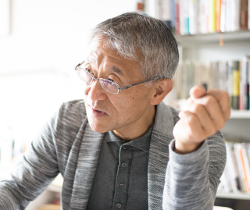AI enhanced by deep learning and reinforcement learning begins to surpass human intelligence

At present, AI (artificial intelligence) is progressing very rapidly, because the progress of technology is accelerating the learning speed of computers. For example, when compared with people having 10 pieces of information, people having 100 pieces of information can understand the situation more comprehensively, more deeply and more accurately. Computers can analyze one billion pieces of information instantaneously, because they are supported by a huge amount of information (big data) which continues to be accumulated, a powerful network connecting an information storage unit (external storage) to each computer, and accelerated improvement of the performance of CPUs which analyze the vast amount of information. Therefore, computers are now endowed with rich sources of information and ever advancing analytical ability. Supported with the progress in these three technical fields, the learning ability of computers in the areas of mechanical learning and deep learning is being strengthened rapidly. Although in precise terms, machine learning means an approach of learning by machines, it has been highly refined into three steps. The first step is supervised learning, in which “the relationship of inputs and outputs” is learned. The next step is unsupervised learning, in which “the structure of data” is learned. The final step is reinforcement learning, in which actions for maximizing the value (reward) are learned through trial and error. Multilayer structured deep learning technology, which enables pattern recognition similar to that of the cranial nerve structure of human beings, is also making rapid progress. In other words, the efficiency of learning has been dramatically improved. In terms of finding the best way to achieve the goal, the considerable advancement of enforcement learning and deep learning techniques has enabled computers to surpass human beings. Owing to the rich storage of data and high analytic ability, computers have intelligence which surpasses that of human beings. As a result, computers are able to make a judgment or prediction which humans would never make. Let’s think of a visible example of AlphaGo. People had been thinking that, although AI defeated human players in chess and shogi, it would not have any chance of beating strong human players in games of go. This was because move patterns in go were very complicated. There were many more squares on a go board than those on a chess or shogi board, and players had to occupy spaces in go instead of taking pieces in chess or shogi. The number of possible moves in chess, shogi (in which pieces can be reused) and go increases exponentially; 10 to the power of 120 in chess, 10 to the power of 220 in shogi, and 10 to the power of 360 in go. AlphaGo was improved by means of deep learning, in which the standard moves are learned, and reinforcement learning, in which the best award of winning is aimed at. It played games repeatedly with itself, and finally became a very strong player faster than expected. In 1997, Garry Kasparov, former world chess champion was defeated by Deep Blue, a super computer developed by IBM exclusively for chess games. In 2013, Shinichi Sato, a leading professional shogi player of the fourth rank, was defeated by an AI software program. This means that it took 16 years for AI to improve from the chess level with possible moves of 10 to the power of 120 to the shogi level with possible moves of 10 to the power of 220. It took only nearly three years, however, for AI to be developed to the go level with possible moves of 10 to the power of 360. The acceleration of technical development was much more rapid than generally expected. Furthermore, AlphaGo began to make unique moves which were difficult to be predicted by leading human players.
AI does not aim at becoming a human-like being
As the development of AI accelerates, an argument is made over the question whether AI is getting conscious and becoming a human-like being. I don’t think, however, that this could not be a significant issue. AI is an abbreviation of artificial intelligence. Although this naming is misleading, AI is not being developed to become a human being. Paradoxically, AI may be able to possess a human-like ability. For example, although it is said that machines cannot have an intuition or an inspiration like human beings, an intuition or an inspiration cannot be formed within a person who is lacking in experience. The amount of experience is increased when the person learns from external knowledge systems and accumulates know-how obtained in his own activities. In other words, he learns things in this manner. An intuition or an inspiration actually means unconscious selection of an optimum item under specific conditions on the basis of lessons learned. Although it is called unconscious selection because the person selects it unconsciously, the selection process is substantially identical to the process of learning and judging executed by AI. Furthermore, the consciousness of a human being is actually a holistic reaction to electrical signals. A person judges information (signals) obtained through the five senses on the basis of experiment (accumulated information.) Since all these processes are thought to consist of reactions to electrical signals, the way in which AI judges is similar to the structure of “consciousness” in a human being. It may be technically probable in future that even “weak AI” could behave like a human. In consideration of the fact that human beings tend to make mistakes readily, it is possible to incorporate this in programming, as mistakes correspond to bugs contained in AI. Is it necessary, however, to do such a thing? It is significant that an autonomous car driven by AI is much safer without causing any accidents, when compared with a car driven by a human who sometimes makes mistakes. This is true not only in the fields of logical judgment and learning, but also in the fields of art, where emotion is thought to be important. Here I put aside a question whether people want to be moved by the music composed and played, or pictures drawn by AI.
AI behaving like a human in this way is quite different from “strong AI” proposed by John Searle. When human consciousness is considered as a system, it should be a “totally operated system carrying a variety of elements,” or an “open system which assumes disturbance and can accept positive feedback.” At present, it is very difficult to understand this as an algorithm. In other words, AI is not becoming a human-like being by acquiring consciousness, but is aiming at surpassing human intelligence in the field of cogitation. I rather think that the world is coming closer to a society where people have to live in symbiosis with AI. For the time being, human beings take charge of target setting, while “weak AI” is in charge of searching an optimum approach to achieve the target and of conducting necessary work in the target area. Since development of digital technology is accelerating, it might be difficult to imagine how the world could change during the next quarter century.
The capabilities of human beings could grow if they live in symbiosis with AI

I think the volume of work to be done by human beings will certainly be decreasing as AI is introduced. Autonomous cars could actually be put into practical use in the near future, and AI driven logistics robots are operated in the warehouses of mail order companies. AI can perform even jobs of professionals known as licentiates. For example, AI can check a huge volume of data more quickly for initial medical diagnosis. Although some people say that hospitality practice can be done only by humans, I think that it is an illusion cherished by Japanese people over a certain age, who are sticking to the idea that AI cannot do human jobs in certain fields.
From a more essential standpoint, human beings are the only creatures on earth that have changed the environment in such a way that they can live there more conveniently, while the other creatures have survived by adjusting themselves to the environment. Only human beings could cultivate lands, make roads, construct plants, harness energy, and change the environment to live more comfortably. Recently, however, the progress of digital technology (represented by AI), which was originally produced by human beings, has created an environment in which machines can develop autonomously using advanced information networks and IoT technology. In other words, there appeared an environment which did not require human intervention. Although people have been living by changing the environment, the present situation means that they cannot live without adjusting themselves to the environment in spite of the fact that it was originally created by them. Of course, there are objections against this way of thinking, and some people like the Amish try to reject modern civilization as far as possible. (The Amish do not deny technology. Although the speed of their acceptance of technology is rather slow, they live in American society, which depends on modern technology.) Basically, however, it is a realistic problem for the majority of people to consider how they should get along with AI. I think it is a nonproductive negative attitude to refuse modern technology, or to argue that the hospitality practice can be done only by humans.
Although many people may feel uncomfortable about the idea of living or working with AI, living in symbiosis with AI could enhance human capabilities. For example, although chess players cannot defeat AI, the rating point (the value indicating the ability of chess players) of Magnus Carlsen, the reigning Grand Master, is extremely high, and he is said to be a player who is the closest to AI. Actually, he has improved his ability by playing chess with AI repeatedly. Shogi players are also said to be studying AI moves. Refusing AI could be an obstacle to human progress.
To prevent Japan from becoming a coelacanth
I think symbiosis with AI would occur in various fields. In order to develop human resources who can cope with this situation, it is necessary to train students to think and judge for themselves by conducting active learning in a true sense, in which activism is denied and suitable loads are applied to students. The education system in Japan is not effective, because students are divided into one group majoring in humanities and the other group majoring in science and engineering, and are led to seek a “proper answer” that is expected by teachers. At the present time, it is essential for all students to acquire technical knowledge for programming regardless of their majoring fields. Fortunately, children today are handling computer-aided devices ever since they can remember. It is necessary to drastically reform the current education system so that the new generation can grow to cope with the new AI environment. We grown-up people as well as current students also have to acknowledge the environmental changes and rapid progress of digital technology, and make efforts to learn and think for ourselves to broaden future choices.
Japanese information devices might be often labelled as Galapagos. I am rather afraid, however, that Japanese society might be becoming a coelacanth in AI use, because Japan, with its strict laws and regulations, is fast becoming a super-aging society. The coelacanth is actually a fish which started to live on land in ancient times after living in shallow brackish water. The body of the coelacanth shows evidence that it used to live on land. Later it returned to the ocean, possibly because it was defeated in the struggle for existence on land, or because it was drawn to the illusion of sea life, and inhabited the deep sea to stop evolving. We have to look straight at the reality of the present situation. If we continue being confined in the Japanese Archipelago, and keep chasing the illusions of humanlike manners and Japanese styles, I am afraid Japan will be left behind by the developing world.
* The information contained herein is current as of November 2017.
* The contents of articles on M’s Opinion are based on the personal ideas and opinions of the author and do not indicate the official opinion of Meiji University.
Information noted in the articles and videos, such as positions and affiliations, are current at the time of production.

